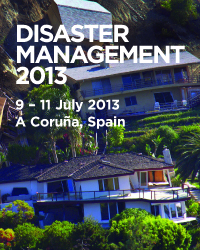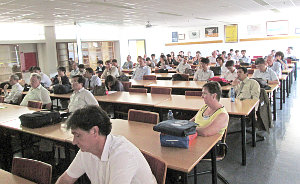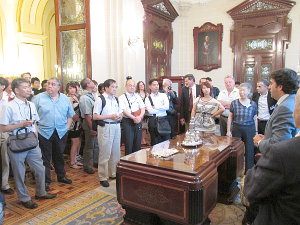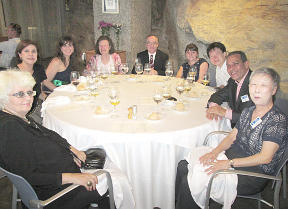3rd International Conference on Disaster Management and Human Health: Reducing Risk, Improving Outcomes
A Coruña, Spain
Overview

The third International Conference on Disaster Management and Human Health: Reducing Risk, Improving Outcomes, was held in A Coruña, Spain organised by Wessex Institute of Technology (WIT). This follows the success of the previous meetings in the New Forest, home of the Wessex Institute (2009) and at the University of Central Florida in Orlando, USA (2011).
The conference originated with the need for academia and practitioners to exchange knowledge and experiences on the way to handle the increasing risk of natural and man-made disasters. Recent major earthquakes, tsunamis, hurricanes, floods and other natural phenomena have resulted in huge losses in terms of human life and property destruction. A new range of human-made disasters have afflicted humanity in modern times; terrorist constraints have been added to more classical disasters such as those due to the failure of plants and industrial installations for instance.
It is important to understand the nature of the new global risk to be able to develop strategies to prepare for these events and define effective solutions in terms of disaster management and the associated human health impacts.
The Conference provided a forum for the exchange of information between academics and practitioners, and a venue for the publication of the latest developments. The corresponding volume of the WIT Transactions on the Built Environment, containing the papers presented at the meeting has been published in paper and digital format, are widely distributed around the world. The papers are also archived in the WIT electronic library (http://library.witpress.com) where they are available to the international community. Papers presented at Wessex Institute conferences are referenced and regularly appear in notable reviews, publications and databases, including referencing and abstract series.

Carlos referred to the growing number of publications produced by WIT and published through its publishing arm, ie WIT Press. They include, in addition to conference proceedings, a substantial number of monographs and edited books as well as international journals. The most appropriate journal for this conference – Carlos said – is Safety and Security Engineering, a publication launched by WIT in collaboration with the University of Rome, La Sapienza.
The Institute research – Carlos explained – continues in advance developments in computer software, which includes solids and fluids, as well as electrical, electromagnetics, acoustics and many other problems. The Institute staff is credited to having been the originators of boundary element method, and a special unit at Ashurst Lodge has developed a computer tool now widely used in industry. This is the best validation of the importance of the work carried out at Ashurst Lodge.
Carlos ended his brief introductory remarks by thanking the delegates for having come to A Coruña and wishing them a very successful conference.
Keynote Address
The keynote address of the conference was delivered by Prof Vincenzo Ferrara of the University of Rome ‘La Sapienza’, on the topic of ‘Smart objects and wireless sensor networks for monitoring: sustainable technology in disaster management’. His paper examined different monitoring methods for the prevention and management of disasters, ie by means of sensor networks and unmanned aerial vehicles (UAV). Each of these two methods has its range of applications: sensor networks are suitable for continuous monitoring and for forecasting, while the monitoring provided by the UAVs has more benefits in an emerging situation.
Conference Topics
The conference programme included a substantial number of papers which were grouped in the following sections:
- Disaster management and mitigation
- Disaster analysis
- Emergency preparedness
- Risk mitigation
- Learning from disasters
- Socio-economic issues
Special Sessions
In addition there were two special sessions organised by well know researchers. The first entitled ‘Critical information and communications technologies for disaster preparedness and response’, was organised by J.W.S Liu, University of California, USA.
The session consisted of six outstanding presentations:
- ‘A linked-data based virtual repository for disaster management tools and applications’, by J.W.S Liu, University of California, USA
- ‘Physical-layer communication recovery for heterogeneous network’, by W.H Chung, Academia Sinica, Taiwan
- ‘Landmark-based self-healing service recovery for distributed pub/sub services on disaster management and M2M systems’, by C.S. Shih, National Taiwan University, Taiwan
- ‘An approach to assess suitable lands for disaster mitigation’, by H Lin, Cheng Kung University, Taiwan
- ‘Participant selection for crowdsourcing disaster information’, by E.T.H. Chu, National Yunlin University, Taiwan
- ‘Trustworthy emergency information brokerage service (TIBS)’,by J.W.S Liu, University of California, USA
Another special session on the important topic of ‘Multihazard risk assessment’ was organised by Dr David Novelo-Casanova of the Universidad Nacional Autonoma de Mexico and consisted of the following papers:
- ‘Integrated risk assessment to natural hazards: case study Motozintla, Chiapas, Mexico’, by D.A. Novelo-Casanova, Universidad Nacional Autonoma de Mexico, Mexico
- ‘Bridging research, policy, and practice: development of an integrated research programme’, by J.E. Rovins, IRDR International Programme Office, China
Excursion

Carlos answered the Mayor stressing how welcome the delegates felt in A Coruña and how positive their comments were regarding the excellent facilities and the local culture.
Prof Santiago Hernandez, member of the Board of Directors of Wessex Institute was also grateful to the City for their welcome and for the support it provides to the University.
After the visit the delegates were offered a buffet lunch at the School of Engineering of the University where afterwards Prof Santiago Hernandez gave a presentation describing the work of the School and in particular its links with WIT and the research being carried out on structural mechanics and earthquake engineering, amongst others. They have contributed also to the organisation of the tail structures in the Airbus A350 as well as the new generation of rotor engines, which aim to provide more economic aircraft.
They have designed a series of bridges as well, in collaboration with many companies in Spain, and are able to serve industry better, because of their powerful computer facilities and their up to date laboratory facilities.
Conference Dinner

Closing of the Conference
The conference was closed by Carlos who once again expressed his personal appreciation, as well as that of his Institute for having participated in yet another successful WIT conference.
Conference Proceedings
The proceedings of Disaster Management 2013 - Disaster Management and Human Health Risk III, 412pp (Print ISBN: 978-1-84564-738-4; eISBN: 978-1-84564-739-1) are available from WIT Press. Orders can be placed on the WIT Press web site at www.witpress.com or by email: This email address is being protected from spambots. You need JavaScript enabled to view it., telephone: +44 (0) 238 029 3223 or fax: +44 (0) 238 029 2853.
Papers from the conference will also be hosted online at the WIT eLibrary as Volume 133 of WIT Transactions on the Built Environment (ISSN: 1746-4498, Digital ISSN 1743-3509). For more details visit the WIT eLibrary at http://library.witpress.com
Related Conferences
- Risk Analysis 2014
- FRIAR 2014
- Sustainable City 2014


 Wessex Institute
Wessex Institute